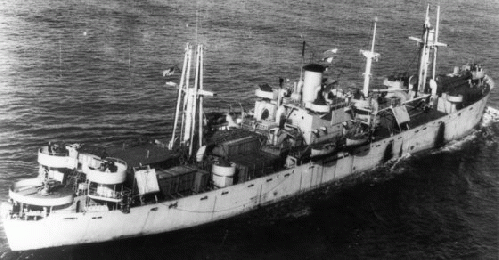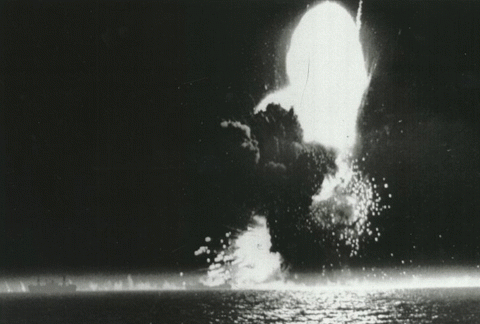When Dad's furlough was over and he returned to Will Rogers Field, he discovered that his squadron, the 32nd Photo Recon, was gone. They'd shipped out suddenly in his absence. He wandered around, sleeping in empty barracks and eating in other mess halls until he got reassigned.

The Liberty Ship, SS Paul Hamilton
(Image by Public domain, Author: Employee of the U.S. Navy) Details Source DMCA
So, if Johnnie had broken off with Dad before his furlough, he might well have been on that ship.

Explosion of the SS Paul Hamilton. Note size of ship at left.
(Image by Public Domain, Author: See Source) Details Source DMCA
But that's not the end of the story. The details of the sinking of the Paul Hamilton were classified for 50 years.
Over 65 years after it went down, Dad found out more when he read the book, He Wore a Pair of Silver Wings: The World War II Memoir of a Lightning Recon Pilot by Thomas K. Follis.
This is what Follis reported about the convoy that included the SS Paul Hamilton:
It was said that the convoy was the largest to cross the Atlantic Ocean. The destination was announced as Italy.
With the exception of some rudder trouble, the first two weeks of the trip were entirely uneventful. The food and sanitation conditions were fair and discipline was good. It was often possible to wave to the men on the other ships.
On Tuesday, April 18, 1944, the coast of North Africa was sighted and the convoy passed through the Straights of Gibraltar into the Mediterranean Sea. From here on, the voyage took on a new aspect. On Thursday, April 20, 1944, at about 1800 hours, a sunny day, an enemy reconnaissance plane was spotted by Captain Maurice Coady and Lt. William E. Pritchard. The ship's captain received a report to expect an enemy air attack that evening. Captain Donald N. McHenry, a Photo Lab Officer, was officer of the day.
At 2100 hours (dusk), about 50 miles form the coast of Algiers, twenty German Junkers 88's came out of the sky, flying at deck level in an attack which only lasted five minutes--some strafed while others dropped aerial torpedoes.
One Liberty Ship immediately forward of the Fitzhugh Lee received a direct hit by a torpedo. The entire ship blew up and disappeared from sight in less than one minute.
It wasn't until the next morning that the identity of the lost ship was discovered. It was the Paul Hamilton, with almost all of the 32nd personnel (20 pilots and 297 enlisted men), other Army units, the Navy and Merchant Marine crews aboard--a total of 547 men--all lost at sea with no survivors.
(Note: You can view every article as one long page if you sign up as an Advocate Member, or higher).






